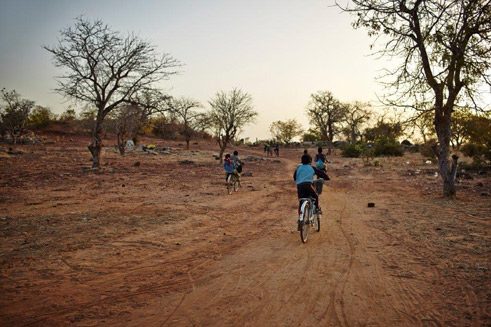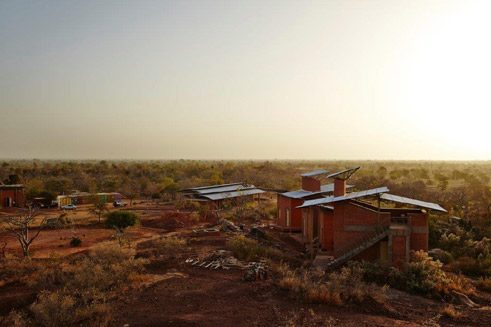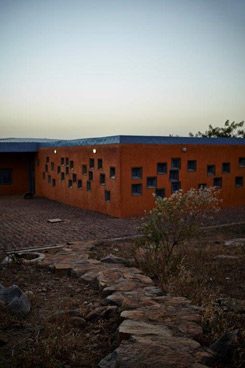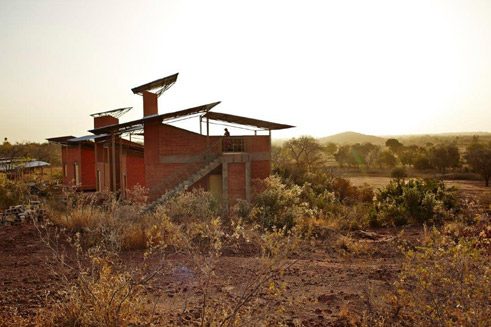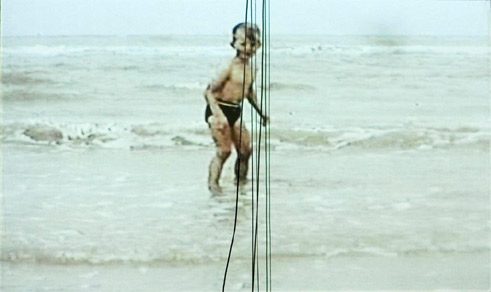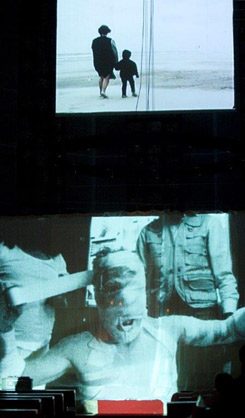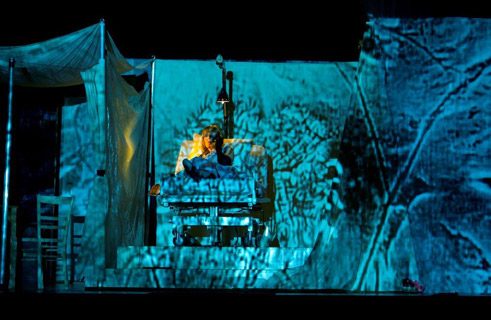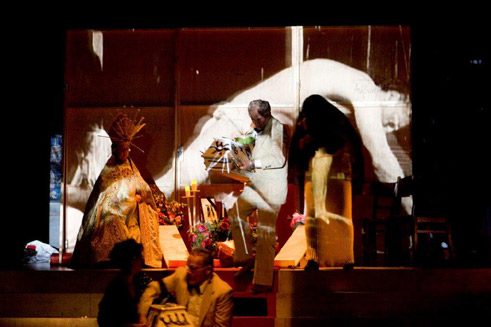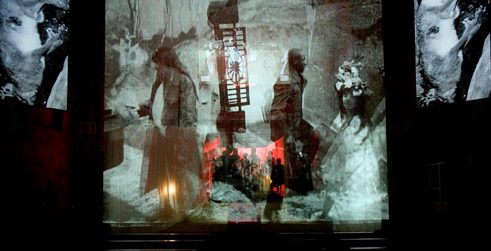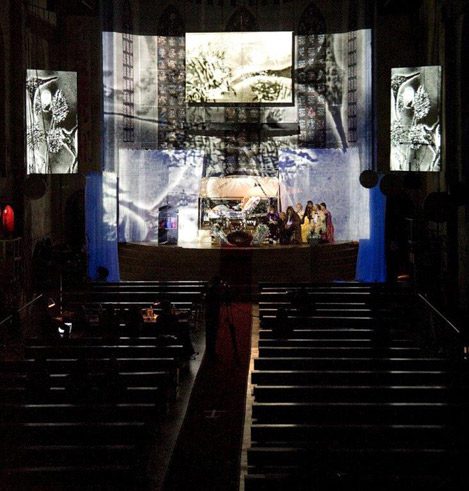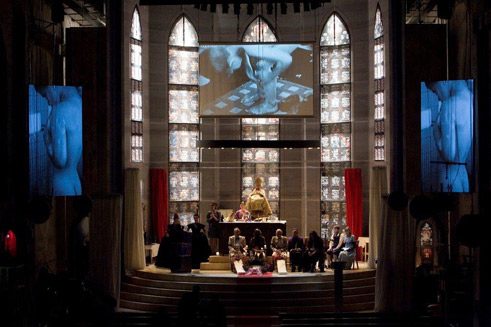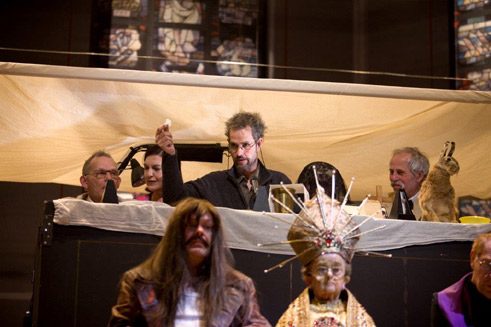Christoph Schlingensief
The Underground Artist
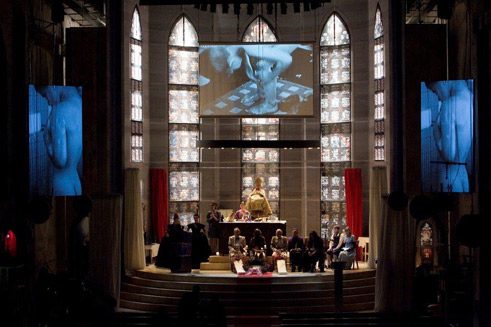
Christoph Schlingensief died 2010 at the age of only 49 years. The action artist’s creative diversity still successfully eludes simple classification. Schliengensief’s former associate Jörg van der Horst poses the question about his contemporary relevance.
Early in 2010 the uneasy feeling crept up on Christoph Schlingensief that he was working too hastily, even too little. Perhaps he sensed how little time remained to him. Sometimes he resigned himself in the face of the superior strength, the constant physical and psychological presence, of his cancer, which had been diagnosed after a routine examination in January 2008. Then he again drew on his own powerlessness, on fear and doubt, driving forces that had shaped his work since the 1980s. He developed a sheer rage for life and a work mania against “this shitty cancer”. What for the people around him had previously been already difficult enough, now became increasingly impossible – namely to keep up with the pace at which Schlingensief thought and acted, at which he, the driven artist, conceived ideas and plans and then again discarded them.
Scratching open the surface
He dedicated two outstanding projects of his last two years to his illness – the Fluxus oratorio Eine Kirche der Angst vor dem Fremden in mir (i.e. A Church of Fear against the Alien Within Me) (2008) and the ready-made opera Mea Culpa (2009). They address his desire to live and the certainty of suddenly having to die before his time. They are conjurations. Schlingensief celebrates himself, his insecurity, his despair and, even more, his future death. This is poignant, a High Mass. It is also kitschy and somehow cruel, an exorcism. But it is truthful. You credit these initiatory rites because they open a panopticon in which he had always been underway.Together with the publication of Schlingensief’s cancer diary, So schön wie hier kanns im Himmel gar nicht sein (i.e. Heaven Can’t Be as Beautiful as It Is Here) (2008), which became a bestseller in Germany, Kirche der Angst and Mea Culpa contributed significantly to a broad and emotional discussion of how public someone should make his private suffering. Especially because Schlingensief made use of the theatre artist’s privilege to act out his suffering on stage. “Made use of”, “acted out” – these are deliberately chosen words in this context. They describe methods pertinent to all Schlingensief’s work. It is the work of an artist who distrusts surfaces and therefore scratches them open. A work difficult to describe, the work of a true underground artist.
To dissect this work into phases would mean interrupting its flow. No matter whether in his home medium of film, in the theatre, in the street, in television, on radio, in the opera or in the museum, Schlingensief always carried bits of previous work in his luggage and mounted them anew, mounted them differently. He painted over his art and frequently even himself. In the fast-paced TV show U3000 (2000), staged in a moving subway car in the actions of the Atta-Trilogie (2003/2004), he poured paint over himself until he became unrecognizable. He was identical with his work. Persistently, he, the underground artist, offered opposition. Opposition to convention, conformism and constants, whether they dominated universal themes, everyday German life or the viewing habits of his own work.
In Schlingensief’s spaces the question is always open whether this is still a staging or already an escalation, the outbreak of art or the breaking in of the real, still a beginning or already an end. What he investigates, dissects and sometimes maltreats in these spaces is the social body. His last project, the African Opera Village (Operndorf Afrika), founded in 2008 in Burkina Faso, therefore does not read like a legacy to posterity that needs to be managed. It is a beginning, goes beyond his death, a vision of the absorption of the arts into the reality of life.
Learning from Africa
Beginning in 1993 Schlingensief travelled more or less regularly to Africa. First to Namibia, then in 1996 to Zimbabwe, where he filmed United Trash in hazardous circumstances. In subsequent years he returned three times to Namibia, formerly German South-West Africa. In 1999 he improvised here a Wagner rally as the last part of his so-called Deutschlandsuche `99 (i.e. Search for Germany ‘99); on a round trip in the spring of 2004 he prepared here his Bayreuth production of Parsifal, which was to bear clear African traits both thematically and artistically: the Bayreuth Festspielhaus on the Green Hill, the epicenter of ur-German Wagner culture, was Africanized and, even more, re-colonized, an idea that was soon also to be fed into Schlingensief’s concept of the “opera village”; and in 2005 he stayed at the harbor city of Lüderitz, where during work on his long-term project Der Animatograph, he installed a mobile revolving stage and filmed scenes for his film monument The African Twintowers, which in turn, in the flow of his work, became the centerpiece of his first major solo exhibition, 18 Bilder pro Sekunde (i.e. 18 Frames per Second) (2007).To interpret Schlingensief’s affinity for the African continent alone in terms of a source of inspiration would fall short of the mark. Odd as it may sound, it also had to do with a temporary escape – from the felt German narrowness and the narrowness of the German cultural scene, so as to find Germany again, as it were, at the other end of the world, there where you least expect it. When we make ourselves viewers of his work, we must always bear in mind his capacity for projection, for overpainting one extreme with the next one. Thus what interests him in Namibia is the assertion of a German parallel universe, such as was imposed by a colonial policy bristling with megalomania, and as shimmers through in many a policy today, and he is fascinated by the simulation game that turns such paradoxes into their opposites, disfiguring them to the point of recognition.
The paradoxical moment is precipitated after all even in the title African Opera Village. Opera? Africa? What sort of knowledge and cultural transfer from the First World to the world degraded to Third is this supposed to be? Schlingensief turns the common understanding of everything from aid programmes to modern messianism completely inside out. “Learning from Africa” and “Do what you want with our money” are slogans he prefixed to the building of this experimental site. With Schlingensief, Fitzcarraldo sets foot in Africa, that romantic adventurer who desired nothing less than to erect an opera house in the Peruvian jungle, nothing less than to realize his productive madness. “Our opera is a village”, said Schlingensief, describing his vision. “A village with a primary school, a birthing ward and an infirmary, sports grounds and rehearsal rooms. A composition of everyday life that wants to be lived.” The frequently invoked “Workshop Bayreuth”, which he was not able to find on the spot, he now asserted in Burkina Faso. There it is now, realizing itself.
Plagues of modern times
With all this heterogeny, an antagonistic principle runs through the Schlingensief cosmos like a common thread, through the films of Deutschlandtrilogie (i.e. Germany Trilogy) (1989-1992), theatre works like 100 Jahre CDU (i.e. 100 Years CDU) (1993), Rocky Dutschke `68 (1996) and Kunst & Gemüse, A. Hipler (i.e. Art and Vegetables, A. Hipler) (2004), the Parsifal productions (2004-2007) and above all the editions of his own total work of art, the Animatographen (i.e. Animatographs) (2005/2006). Birth meets comic, chaos Adorno, passion ossification, isolation mass hysteria and carnival death. The lightness of being runs into complete overload, poetry into the drastic. Security is nowhere to be found; Schlingensief’s almost holy earnestness, on the other hand, is everywhere.Not only in comparison with the work of other artists is his work characterized by a breath-taking otherness; it is also so marked and especially so in relation to itself. Incompatibilities and nonsense here are inevitable, and intended. Schlingensief brings the eternal contradictions and plagues of modern times onto the stage. This may sound like missionary zeal, like moralistic commitment, but in its actual artistic practice it is exactly the opposite. He called his films crimes; others called his theatre violent. Where others celebrated the sacrificial lamb, he preferred the role of the perpetrator. It is the dogmatists and prophets of salvation that Schlingensief finds suspect. Whether they preach from the pulpit, from parliaments, from the television or even from the stage, in his eyes all those who would make you believe in some absolute make themselves untrustworthy.
With Church of Fear (2003), Schlingensief raised a monument to the unbelievers by setting them on pillars at the Biennale di Venezia. He cultivated thinking differently – and being different. The mentally and physically disabled who began to work with Schlingensief in the 1990s do not represent unfortunates and people marked by fate, as they are often carelessly labelled. In Schlacht um Europa (i.e. Battle for Europe) (1997) at the Berlin Volksbühne and in the TV magazine Freakstars 3000 (2002) they embody the enviable ideal, people who are at one with themselves, who need not stage themselves in order to present themselves. In view of this natural expressiveness, only the role of an extra remains for any professional actors. Schlingensief’s intuitive theatre of unlmited opportunity is first constituted by the disabled. They set the pace and effect the gaps in the play of a well-oiled performance, which he felt was the greatest happiness.
The junkies, homeless and unemployed, whom Schlingensief made into main characters in projects such as Notruf für Deutschland (i.e. Emergency Call for Germany) (1997) and Chance 2000 (1998), do not function as the bad conscience of an anonymous society; they show themselves as individuals who speak for themselves. They are autonomous cells. The same applies to the seven neo-Nazis whom Schlingensief had voice their views as the actors troupe within the play in his version of Hamlet (2001). And the same applies to Schlingensief himself. He is at the centre of his work, but refrains from inflating himself.
During the action Bitte liebt Österreich (i.e. Please Love Austria) (2000), Schlingensief moderated the nightly deportation of asylum seekers who were interned in a container labelled “Foreigners Out”. For a time this gave him the reputation of being inhuman, hungry for fame or at least publicity-seeking. But the concentrated humiliation of the action was based on the explosive mixing of quotations from then campaigning politicians and on the concept underlying the world-wide TV hit Big Brother. Thus once again Schlingensief played through a worst case scenario that others had predetermined.
Role models?
When it comes to a fundamental positioning of the person Christoph Schlingensief within his projects, no word is more frequently heard than that of “provocateur”. It seems almost like a job description, because it can be arbitrarily stretched between the meaning of total rejection on the one hand and recognition of a supposedly anarchic attitude on the other. Schlingensief favoured instead the term “self-provocation”; after all, he laid himself open to his own experimental arrangements. “Assume liability” is his motto.Artists like Joseph Beuys and Paul McCarthy, the Viennese actionists and Matthew Barney, appear again and again in his work; and Richard Wagner is a virtual leitmotif. They are never mere references, but are always questioned by Schlingensief and sounded for their practical value. To discern in him only a belated Dadaist, Situationist or Deconstructivist does justice to no one. If he names Luis Buñuel as his only model and quotes André Breton, his own direction is nevertheless not surreal because it does not practice aesthetic hyperbole, is not reflected in phantasms. Perhaps Schlingensief is a subrealist. He does not turn the subconscious inside out. He abstracts the conscious, what actually lies right under our noses. Certainly he is an eclecticist and archaeologist of the present, who excavates its found pieces and uses them again and again. The boundaries that he blurs are always the boundaries of art and its styles.
Hotbed on the offside
All in all, Schlingensief remains a marginal, even after very establishment invitations to the Vienna Burgtheater, Bayreuth and the German Pavilion in Venice, which he was to design for the 2011 Biennale. The passion with which he came to grips with the world from this position allows the inference that he found his hotbed in the offside. His work – this must be said with allowable emphasis – is a work at the end of art, perhaps its epilogue, and therefore always only in the making, always a departure and start.Schlingensief’s death on 21 August 2010, at the age of only 49, was an inexcusable waste of creativity and self-will. Germany, perhaps even the world, and quite certainly the world of art, lost a berserker, ruthless towards himself and others, curious and in his curiosity filled with a captivating enthusiasm. The uniqueness of his work is shown in its diversity, its ambivalence and its lust for syncretism in form and content. His post in the underground is now vacant. His exuberant courage to intervene in the space between art and the life-world has yet to find a successor. As far as we can see, there is no one like him, the explorer, the criminal, the subrealist, who tampers lock, stock and barrel with the surfaces of his time. Probably this is why it is almost impossible to measure Schlingensief’s continued influence in the arts. Of course there are epigones and legacy hunters who facilely write his name on their banners. Let it be said to their credit that they don’t know better, that they could not know him better just because he died so young and was so abruptly torn from the flow of his work. If he generated productions, actions, projects and installations that may certainly be called groundbreaking, there remains the feeling that this was above all his own path. A path that no one else can take because it is completely bound up with the person, and also with the brand name, of Schlingensief. Now is the time to explore Christoph Schlingensief and to take journeys in his work. To discover him, his art, his veracity. Under the surfaces. In the underground.
